Nursing pnn101 Samenvattingen, Notities en Examens
Op zoek naar een samenvatting over Nursing pnn101? Op deze pagina vind je 33 samenvattingen over Nursing pnn101.
Alle 33 resultaten
Sorteer op
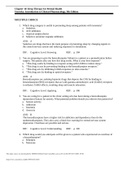
-
NURSING PNN101Chapter 03 to NURSING PNN101Chapter 22, Vislosky: Introduction to Clinical Pharmacology, 9th Edition
- Voordeelbundel • 17 items • 2022
-
- $35.49
- 1x verkocht
- + meer info
herapy for Mental Health ,Antivirals and Antiretrovirals,Drug Therapy for Central Nervous System, Drugs Affecting theRenal/Urinary and Cardiovascular ,Anti-infective Drugs: Antibacterial, Antitubercular, and Antifungal,Anti-inflammatory, Antiarthritis, and Antigout Drugs ,Physical Assessment question and answers,Hormones and Drugs for Osteoporosis
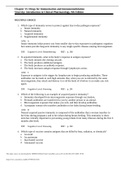
-
NURSING PNN101 Chapter 15: Drugs for Immunization and Immunomodulation Visovsky: Introduction to Clinical Pharmacology, 9th Edition
- Tentamen (uitwerkingen) • 6 pagina's • 2022
- Ook in voordeelbundel
-
- $8.49
- 1x verkocht
- + meer info
1. Which type of immunity serves to protect against day-to-day pathogen exposure? a. Innate immunity b. Natural immunity c. Acquired immunity d. Supplemental immunity ANS: A Innate immunity helps protect you from smaller day-to-day exposures to pathogenic organism but cannot provide long-term immunity to any single specific disease-causing microorganism. DIF: Cognitive Level: Remembering REF: p. 280 2. In acquired immunity, what is the body’s response to antigen exposure? a. The body...
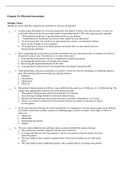
-
NURSING PNN101>Chapter 21. Physical Assessment question and answers
- Tentamen (uitwerkingen) • 30 pagina's • 2022
- Ook in voordeelbundel
-
- $10.49
- + meer info
1. A nurse wakes the patient for a focused assessment. The patient, trying to rest, tells the nurse, “I wish you would quit waking me up. Do you really need to keep bothering me?” The nurse appropriately responds: 1. “Most patients would love to get the attention that you are getting.” 2. “I understand your frustration, but this has been ordered by your physician.” 3. “It is necessary that I do a head-to-toe assessment from which I can determine whether there are any changes i...
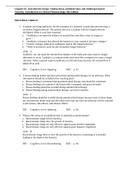
-
NURSING PNN101>Chapter 05: Anti-infective Drugs: Antibacterial, Antitubercular, and Antifungal Agents Visovsky: Introduction to Clinical Pharmacology, 9th Edition
- Tentamen (uitwerkingen) • 12 pagina's • 2022
- Ook in voordeelbundel
-
- $9.49
- + meer info
Chapter 05: Anti-infective Drugs: Antibacterial, Antitubercular, and Antifungal Agents Visovsky: Introduction to Clinical Pharmacology, 9th Edition MULTIPLE CHOICE 1. A patient receiving antibiotics for the treatment of a bacterial wound infection develops a secondary fungal infection. The patient asks you to explain why the fungal infection developed. What is your best response? a. “Antibiotics can upset the balance of normal flora and allow yeast or fungus to grow.” b. “Antibioti...
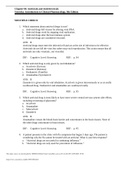
-
NURSING PNN101 Chapter 06: Antivirals and Antiretrovirals Visovsky: Introduction to Clinical Pharmacology, 9th Edition
- Tentamen (uitwerkingen) • 9 pagina's • 2022
- Ook in voordeelbundel
-
- $8.49
- + meer info
1. Which statement about antiviral drugs is true? a. Antiviral drugs kill viruses by altering viral DNA. b. Antiviral drugs work by stopping viral replication. c. Antiviral drugs alter the host immune system. d. Antiviral drugs are considered virucidal. ANS: B Antiviral drugs must enter the infected cell and act at the site of infection to be effective. Antivirals do not kill the virus but rather stop viral reproduction. This action means that all antivirals are only virustatic, not viru...
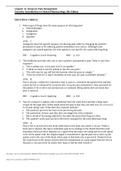
-
NURSING PNN101 Chapter 11: Drugs for Pain Management Visovsky: Introduction to Clinical Pharmacology, 9th Edition
- Tentamen (uitwerkingen) • 6 pagina's • 2022
- Ook in voordeelbundel
-
- $8.49
- + meer info
1. What types of drugs have the main purpose of relieving pain? a. Anticholinergics b. Antagonists c. Analgesics d. Agonists ANS: C Analgesics have the specific purpose of relieving pain either by changing the patient’s perception of pain or by reducing painful stimulation at its source. Although some analgesics are opioid agonists, the term agonist is not specific for a pain-relieving drug. DIF: Cognitive Level: Knowing REF: p. 213 2. The healthcare provider asks you to rate a patie...
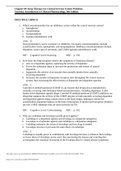
-
NURSING PNN101Chapter 09: Drug Therapy for Central Nervous System Problems Visovsky: Introduction to Clinical Pharmacology, 9th Edition
- Tentamen (uitwerkingen) • 7 pagina's • 2022
- Ook in voordeelbundel
-
- $8.49
- + meer info
Chapter 09: Drug Therapy for Central Nervous System Problems Visovsky: Introduction to Clinical Pharmacology, 9th Edition MULTIPLE CHOICE 1. Which neurotransmitter has an inhibitory action within the central nervous system? a. Epinephrine b. Acetylcholine c. Norepinephrine d. Gamma-aminobutyric acid ANS: D Neurotransmitters can be excitatory or inhibitory. Excitatory neurotransmitters include acetylcholine (Ach), epinephrine, and norepinephrine. Inhibitory neurotransmitters include do...
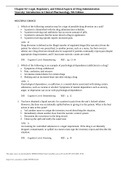
-
NURSING PNN101 Chapter 02: Legal, Regulatory, and Ethical Aspects of Drug Administration Visovsky: Introduction to Clinical Pharmacology, 9th Edition
- Tentamen (uitwerkingen) • 5 pagina's • 2022
- Ook in voordeelbundel
-
- $8.49
- + meer info
Chapter 02: Legal, Regulatory, and Ethical Aspects of Drug Administration Visovsky: Introduction to Clinical Pharmacology, 9th Edition MULTIPLE CHOICE 1. Which of the following scenarios may be a sign of possible drug diversion on a unit? a. A patient is dissatisfied with the drug administration schedule. b. A patient receiving oral antibiotics has an excess amount of pills. c. A patient is unaware that the nurse mixed a drug in applesauce. d. A patient receiving opioids reports increased...
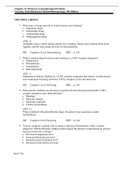
-
Chapter 13: Drugs for Gastrointestinal Problems Vislosky: Introduction to Clinical Pharmacology, 9th Edition
- Tentamen (uitwerkingen) • 7 pagina's • 2022
-
- $9.99
- + meer info
Chapter 13: Drugs for Gastrointestinal Problems Visovsky: Introduction to Clinical Pharmacology, 9th Edition MULTIPLE CHOICE 1. What types of drugs prevent or control nausea and vomiting? a. Antiemetic drugs b. Antimotility drugs c. Antidiarrheal drugs d. Antipropulsion drugs ANS: A Antiemetic drugs control nausea and prevent vomiting. Nausea and vomiting often occur together, and the same drugs are used for both problems. DIF: Cognitive Level: Remembering REF: p. 242 2. Which common drug for na...
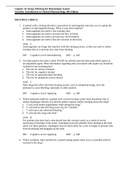
-
Chapter 14: Drugs Affecting the Hematologic System Visovsky: Introduction to Clinical Pharmacology, 9th Edition
- Tentamen (uitwerkingen) • 10 pagina's • 2022
- Ook in voordeelbundel
-
- $9.49
- + meer info
1. A patient with a clotting disorder is prescribed an anticoagulant and asks you to explain the purpose of anticoagulant therapy. What is your best response? a. Anticoagulants are used to lyse existing clots. b. Anticoagulants are used to increase the flow of blood. c. Anticoagulants are used to prevent new clot formation. d. Anticoagulants are used to thin the viscosity of the blood. ANS: C Anticoagulants are drugs that interfere with the clotting process, so they are used to reduce ex...



